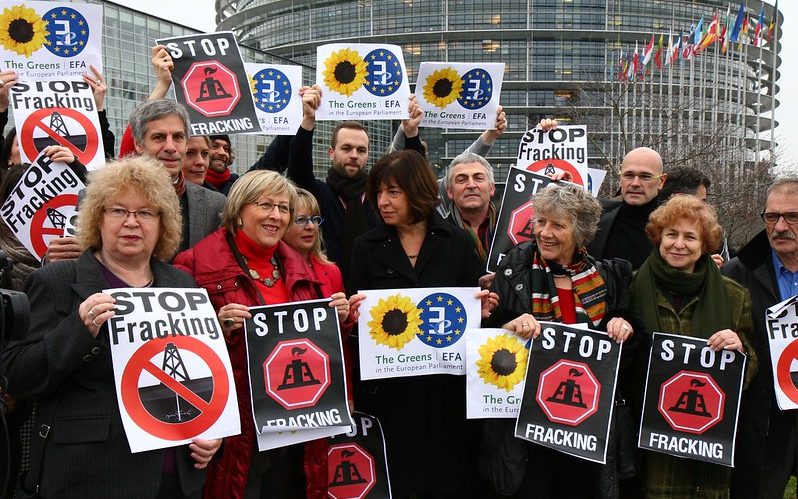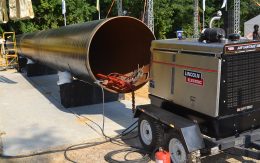As a result of Russia’s invasion of Ukraine, international energy prices have reached new heights, and it is expected they will remain high as 2023 continues (Hall, 2022), especially for European countries still relying on Russian energy resources. That is why the question of whether Europe could achieve energy independence by utilising its own energy resources has started to appear. In recent months, several countries have started investigating the possibility of reviving hydraulic fracturing (HF) or fracking, with the former UK Prime Minister Liz Truss lifting the ban, and Hungary giving its green light to the industry (Peigné, 2022). Therefore, this article aims to explore the implications of the HF technology and, after examining the limited possibilities of European countries achieving energy independence, argue in favour of lifting the ban on fracking while providing reasons for such a decision.
To a large extent, the current energy crisis is a result of European sanctions on Russia and its decision to decrease imports of oil, coal, and natural gas of Russian origin. Although it can be debated whether this has achieved the desired effect, it has, nonetheless, resulted in an 18% drop in Russian exports in August compared to February 2022. However, this crisis is not just a result of the Russian invasion, but also of the postponed Covid-19 crisis that resulted in labour strikes, shortfalls in refining capacities, and supply constraints (Jayanti, 2022). Furthermore, there is not nearly enough energy diversification in Europe, and some countries like Germany have put themselves in a situation far worse than any of their neighbours. By engaging in the so-called Ostpolitik with an emphasis on building energy links between the West and the East (Holland, 2022), they have been engaging in blind trade with Russia from the earliest pipeline deal in the 1970s to the 2005 contract for Nord Stream 1, and the 2015 agreement for Nord Stream 2. This has resulted in their vulnerability to external shocks such as Russia’s actions in Ukraine and has put them in an especially risky situation (Wintour, 2022). With one of the pipelines damaged beyond repair since September, Germany’s energy future, as well as the future of Europe as a whole, is at stake.
Even though several European countries are rushing in building liquified natural gas (LNG) terminals that enable imports of gas from producers like the US, this option is neither economical nor fast. Building LNG terminals takes approximately two to five years, and the suppliers might even run out of stock as demand exceeds supply. Based on current projections, the time it takes for the LNG markets to stabilize ranges from three to five years at best. Building new pipeline infrastructure connecting European countries to outside suppliers also takes anywhere from one and a half to four years, and the question remains whether investors would be willing to finance such expensive operations. On another hand, renewable energy infrastructure could be built relatively cheaply and quickly, but due to the extent of the energy crisis, it cannot possibly be used to supply the entire market with much-needed electricity, but only complement it. And lastly, with Germany and some other countries having decommissioned their last nuclear power plants just before the invasion, building and licensing new ones would take anywhere up to 10 years (Jayanti, 2022). Europe does not have that much time.
The Case for Fracking
With most of the alternative options examined, it makes sense to turn our attention to fracking. Even before the energy crisis started, the advancements in horizontal drilling techniques and multistage HF have made fracking an economically attractive option. However, by 2016, only four countries – the United States, Canada, China, and Argentina – had commercial production of shale gas. At present, the US remains the largest producer of natural gas and its development was proven to be able to reshape energy policies, as well as alter energy security and geopolitics. As a result of the fracking industry, the US is no longer dependent on oil imported from the Middle East (Cachola et al., 2022). The US success can highlight one of the clearest arguments in favour of embracing fracking as one of the primary energy sources – energy diversification and its positive impact on European energy security, now that it needs it most.
Therefore, the first argument in support of fracking is its contribution to European energy security, which is supported by several papers discussing the topic from a holistic approach. Reports like the one from Bazilian et al. (2013) come to this conclusion by looking at the developments in the energy markets as they occurred in real time. They write that, as soon as the US overtook Russia as the largest producer of natural gas in 2009, both Europe and Russia’s biggest players like Gazprom became well aware that, if Eastern Europe were to pursue the extraction of its shale gas reserves, that would establish greater foreign policy independence as it would reduce Russia’s political leverage. That is why Gazprom has sped up the plans for their South Stream pipeline but by 2011, discussions at the European Unconventional Gas Summit in Paris were already mentioning solutions such as LNG in combination with domestic shale gas reserves as having potential in supporting the development of a much more competitive European gas market (Bazilian et al., 2013). This was also confirmed after Russia annexed Crimea in 2014 when it became even clearer that Europe has strategic reasons to avoid purchasing natural gas from Russia altogether. A briefing released for the European Parliament titled “Shale gas and EU energy security” explicitly mentions strategic reasons for pursuing the extraction of considerable shale formations in Eastern Europe as it can offset the declining production of domestic natural gas in the medium and long term (Erbach, 2014).
Submit here
However, due to a lack of interest, all big multinational energy corporations interested in shale gas extraction soon exited the region. This was the result of a lack of skilled workforce and equipment, lower oil prices in Eastern Europe, higher cost of exploring new potential shale gas deposits due to Europe’s geology, and most importantly, land possession not including ownership of underground resources, consequently decreasing the public support in governments’ attempts for the exploration process. However, factors that were known to be able to reverse this decision even before the start of Russia’s war in Ukraine were a dramatic increase in energy prices, escalated tensions with Russia, and the consequential need for diversification of European energy resources (Maierean, 2021). All these factors are now fulfilled and thus the need to revisit this topic is vital.
A possible counterargument to our reconsideration of a European shale industry is that we can easily import gas from outside the continent. As a result of imports, 94.3% of the EU’s gas storage for the winter of 2022 was full as per Reuters (Evans & McClure, 2022). However, this has mostly been due to suppliers like the US taking advantage of higher energy prices. Although many countries have prided themselves on filling up their gas storages so quickly, this poses a long-term concern as many of the US suppliers are already signalling that their production capabilities are at their maximum. There are also no further shipments planned, as well as no intentions of adding new drilling rigs, mostly due to investors’ dislike of the shale sector pursuing a growth model as capital availability is extremely limited (Jacobs & Brower, 2022). This sentiment makes it clear that Europe cannot, and should not, rely on external suppliers for future crises as it is already massively overpaying for imports that are draining its economy.
Another counterargument could be that the US’s success is hard to replicate, especially as the current literature estimates that Europe is only at the beginning of shale exploration, a process which took the US decades. Similarly, projections estimate that for shale gas to offset the domestic decline in conventional gas production, Europe would have to pursue a large-production scenario (Spencer et al., 2014). And lastly, the US success can be largely attributed to the legislative and financial systems supporting production and issuing permits, as well as advanced natural gas and oil sectors being able to provide services like HF and drilling in a fast manner (Maierean, 2021). However, as we have seen with the EU’s overwhelming support for Ukraine, important decisions can be reached in a fast manner if the incentive is big enough, and the energy crisis that Europe is currently experiencing seems to be an extraordinary situation where legislation should work in a faster-than-normal manner.
A promise of the industry and the second argument in favour of fracking in Europe is the contribution to its economy via job creation. In the US, the industry is estimated to impact anywhere between 0.3% to 1% of the entire US GDP and has created around 600,000 jobs, either directly or indirectly, with the figure projected to reach over 1.6 million by 2035. In other words, for each million dollars worth of natural gas or oil extracted via fracking, 0.53 jobs were created in that county for the period between 2005 and 2012, as well as 2.4 jobs in counties within 100 miles of production. Without the sector, a recovery of a lot of traditional industries like plastics and petrochemicals would not have been possible (Mason et al., 2014). A report examining the theoretical impacts of shale gas fracking in the UK predicts that the industry could generate up to 74,000 jobs, comprised of construction workers, geologists, engineers, business analysts, truck drivers, and public relations staff, although the more realistic estimates have put this figure between 16,000 and 32,000 based on assumptions from the US scenario adjusted for the UK context. Nevertheless, this would represent a 7% employment increase in the UK oil and gas sector alone (Shale Gas Rural Economy Impacts, 2015).
Although not involving job creation per se, the shale gas industry is paying a lot of royalties to landowners who own the rights to surface minerals on their property, and approximately 70% of production takes place on private lands. This accumulates to around 0.1% of national US income, or up to 0.5% of state income, meaning the industry is heavily interconnected with local communities, states, and the federal government, which further profits from impact fees, permitting, and taxation (Mason et al., 2014).
Opposition to Fracking
However, possible counterarguments to job creation have been expressed by NGO groups like Friends of the Earth, who claim that one of the sources that the UK government report cites is relying on misleading numbers which are twice as high as the US fracking level employment (Fracking job creation ‘overstated’, friends of the Earth Report claims, 2015). This makes us question the reliability of job prospects written in many reports sponsored by oil and gas companies, also highlighting the possibility of a conflict of interest.
Even if the job reports are reliable, this could increase social impacts on rural communities where these jobs are supposed to appear. Increased congestion and noise are expected in a 5-mile radius of drilling sites, negatively impacting the prices of real estate in proximity. Based on data from similar sites in Texas, Pennsylvania, and Alberta, this drop could be as high as 14%, although the factor of workers seeking accommodation near working sites and, consequently, driving real estate prices upwards has not been considered. Lastly, it could also put pressure on local services like healthcare and education, not built to withstand the move of many workers into smaller towns. This has not been a big issue in Australia and the US where fracking was established near towns that have experienced periods of depopulation and have since sat empty. Overall, it is hard to reliably anticipate any of the negative externalities which have occurred outside Europe simply due to a different state in which these countries have found themselves (Shale Gas Rural Economy Impacts, 2015).
The biggest counterargument to the pursuit of fracking in Europe altogether is that it would bring major problems like a negative impact on the environment. It is widely considered that HF has a big impact on water, which is not only being used in large amounts but is also contaminated, and this wastewater could accidentally be released into the environment due to a variety of reasons.
In terms of high water usage, a single well typically requires anywhere between 2 to 4 million gallons of water, and some have been reported to require anywhere up to 20 million. However, it is important to note that this includes all types of water, ranging from groundwater and surface water to treated wastewater, and the question should be whether its use could negatively impact the public’s access to clean drinking water. Yet, because of the higher costs associated with using fresh water, producers have accelerated their efforts to decrease these costs by increasingly using recycled water (Glowacki & Henkel, 2013), which is a step in the right direction. Although the amount of water usage is considerably large in fracking, it is also important to put this into context. In Texas, these numbers amount to less than 1% of its overall water consumption, although this can range higher when speaking of specific counties. Nevertheless, when compared to other energy sources, shale gas extraction and processing consumes less water than most other forms of energy, except for conventional natural gas and renewables like photovoltaics and solar which consume virtually none. Despite getting a lot of negative attention from the public, water consumption for extraction of coal is around two times, for nuclear around three times, and for oil around 10 times greater in comparison to shale gas. In the case of corn ethanol production where plants need to be irrigated for evaporation to occur, approximately 1,000 times more water is used than in fracking (Jackson et al., 2014).
Shifting our attention from high water usage to potential freshwater contamination, water in fracking does not stay underground but flows back towards the surface in a process called flowback of fluids and must be treated as well as properly stored. For this operators use specially designed tanks and pits for temporary storage before wastewater can be disposed of (Glowacki & Henkel, 2013). It typically contains contaminants such as metals, salts, barium, arsenic, and radioactive radium. In Pennsylvania, most such contaminated water is recycled, and the remainder is sent to private-water treatment facilities, which can successfully remove around 90% of metals according to independent studies. Considering public wastewater management facilities are not properly equipped to handle such special treatment, their involvement in fracking wastewater treatment is slowly being discontinued. Both pathways of water contamination, including surface leaks from wastewater holding pods and inadequate treatment before wastewater discharge, are relatively rare. Other contamination situations such as HF accidentally opening incipient fractures, and connecting shallow drinking water with fracturing chemicals migrating upwards from thousands of meters underground, are also unlikely because of the increasing depths at which shale gas is being extracted (Jackson et al., 2014).
Another environmental concern of fracking achieving considerable attention from civil society is induced seismicity, which is defined as earthquakes associated with human activity, one of which is HF. It occurs after high-pressure fluids are injected to create an open fracture network that enhances fluid flow. The first reported induced seismicity due to fracking was reported in 1979 in Love County, Oklahoma, with a magnitude of 1.9, and the number of cases has since increased tenfold in the US and with a rate of three in western Canada (Atkinson et al., 2020). However, only a handful of fracking-related earthquakes with a high magnitude have been documented, usually not exceeding a magnitude of 4.0. Again, it is important to put things into perspective. The number of induced seismicity that we can contribute to fracking is small compared with other anthropogenic triggers like reservoir impoundment, salt solution mining, oil field depletion, and waste disposal (Jackson et al., 2014). In addition, statistical studies from western Canada, where fracking is widespread, indicate that only 0.3% of horizontally drilled fracturing wells are directly correlated with earthquakes equal to or larger than a 3.0 magnitude, with wide deviation among regions. Sometimes, it can be also difficult to distinguish between induced and natural earthquakes, leading to widespread debates within the public as well as academia. Regardless, developments of new technologies like machine learning, dense real-time monitoring, and imaging of fracking operations, are showing promising results in predicting seismic risk (Atkinson et al., 2020).
Among arguments listed by the authors of studies themselves, such as water usage being lower in comparison to other power generation methods, technology advancing to a point where the majority of contaminants can be removed before disposal, as well as seismic activity possibly being predicted, the most important environmental argument for support of fracking concerns emissions, and is fairly surprising: fracking could decrease emissions. One of the side effects of fracking is usually a lower use of coal-fired power plants as countries diversify their energy resources, and this is exactly what happened in the US. As the production of electricity from natural gas increased by 5% in 2012, the one from coal decreased by the same amount. From 2007 to 2012, this represented 450 million tons – the largest decrease ever recorded in the world (Le, 2018). Similarly, the same applies to the quality of air, which is especially important for communities nearby coal-fired power stations, known to emit local and regional pollutants like mercury, sulfur dioxide, and fine particulate matter. With their use decreased as a result of shale gas fracking, the air in its surroundings becomes cleaner (Mason et al., 2014).
Although the argument of fracking decreasing emissions has been contested by some researchers who argue that by taking into account potential methane contamination during the HF process, the long-term greenhouse gas footprint could be comparable or higher to that of coal or oil. However, the same authors also admit that the venting process and methane leakage can be decreased by improving the pipeline and storage systems, as well as with the development of gas-capturing technology (Howarth et al., 2011).
All the examined arguments in favour of and against fracking bring us to an overseen factor playing a big role in public perception of HF – shaping of public opinion via media, giving rise to bias and polarization along party lines. Based on research from the US, people have been found to have limited awareness of the technology, and those more familiar with it are more likely to be supporting it (Gearhart et al., 2019). This was confirmed by another study examining the public’s connotation concerning fracking. The findings show that when fracking is presented as shale oil or gas development, a greater percentage support it (Clarke et al., 2015), pointing to the fact that most Americans do not understand what the HF technology represents, with possibly the same being true outside the US. A key factor of political ideology has also been observed by both studies, with liberals more likely to harbour negative views in comparison to conservatives. This can be explained by media coverage that does not enhance the public’s limited knowledge of HF but is instead split along party lines, with Fox News on one side and MSNBC and CNN on the other. This highlights the issue of content producers selectively presenting topics that align with the predetermined reporting outlet’s stance, without relying on experts from the energy industry (Gearhart et al., 2019). Consistent with the framing theory, the general sentiment of people when exposed to both the possibilities of negative effects on the environment as well as the benefits of job generation, the general attitude towards fracking is expected to be negative (Christenson et al., 2017).
Ending the European Energy Crisis
In conclusion, the current once-in-a-lifetime energy crisis seems to be big enough of a justification to consider all possible domestic energy sources as a replacement for Russian oil and gas. To increase Europe’s long-term energy security by becoming independent of all external energy resource providers, a stronger discourse with the energy industry needs to be established. Keeping environmental sustainability goals in mind while reviewing the feasibilities of most energy generation methods as well as their implications on our society, if fracking is pursued now, it could provide a medium to a long-term solution to the declining domestic energy production and contribute to European energy independence. As energy costs increase and Europe’s emergency energy supplies run dry, we can expect pressure from the public to increase, which is already happening as winter continues and people start protesting against the embargo on Russian energy. For the European energy crisis to end and for negative public perception of fracking to improve, the ban on HF should be lifted and constructive dialogue between international institutions, countries, energy experts and local communities established, so that the people are informed of the shale industry’s implications on their lives, as well as what is at stake – with the latter one discussed in detail, the logical choice considering the circumstances should be “yes”.
Sources
Atkinson, G.M., Eaton, D.W. and Igonin, N., 2020. Developments in understanding seismicity triggered by hydraulic fracturing. Nature Reviews Earth & Environment, 1(5), pp. 264-277. Available at: https://www.nature.com/articles/s43017-020-0049-7 [Accessed 1 November, 2022]
Bazilian, M., Pedersen, A. and Baranes, E., 2013. Considering shale gas in
Europe. European Energy & Climate Journal, 3(1), pp. 37-57. Available at: https://www.elgaronline.com/view/journals/eecj/3-1/eecj.2013.01.03.xml [Accessed 3 November, 2022]
Cachola, C.da et al., 2022. Assessment of the possibilities and challenges of shale gas in the global energy transition. Society and Development, 11(3). Available at: https://rsdjournal.org/index.php/rsd/article/view/26282 [Accessed 31 October, 2022].
Christenson, D.P., Goldfarb, J.L. and Kriner, D.L., 2017. Costs, benefits, and the malleability of public support for ‘Fracking’. Energy Policy, 105, pp. 407-417. Available at: https://www.sciencedirect.com/science/article/pii/S0301421517301428 [Accessed 4 November, 2022]
Clarke, C.E. et al, 2015. Public opinion on energy development: The interplay of issue framing, top-of-mind associations, and political ideology. Energy Policy, 81, pp. 131-140. Available at: https://www.sciencedirect.com/science/article/pii/S0301421515000920 [Accessed 4 November, 2022]
Erbach, G., 2014. Shale Gas and EU Energy Security. European Parliamentary Research Service. Available at: https://www.europarl.europa.eu/RegData/etudes/BRIE/2014/542167/EPRS_BRI(2014 )542167_REV1_EN.pdf [Accessed 31 October, 2022].
Evans, D. and McClure, J., 2022. How much of Europe’s gas storage is filled. Thomson Reuters. Available at: https://graphics.reuters.com/UKRAINE-CRISIS/EUROPE-GAS/zdvxozxzopx/ [Accessed 31 October, 2022].
Fracking job creation ‘overstated’, friends of the Earth Report claims,
2015. BusinessGreen News. Available at: https://www.businessgreen.com/news/2390926/fracking-job-creation-overstated-frien ds-of-the-earth-report-claims [Accessed 4 November, 2022]
Gearhart, S., Adegbola, O. and Huemmer, J., 2019. Where’s the fracking bias?: Contested Media Frames and news reporting on shale gas in the United States. Energy Research & Social Science, 51, pp. 168-175. Available at: https://www.sciencedirect.com/science/article/pii/S2214629618309046 [Accessed 4 November, 2022]
Glowacki, J. and Henkel, C., 2013. Hydraulic Fracturing in the European Union: Leveraging the U.S. Experience in Shale Gas Exploration and Production. Indiana International & Comparative Law Review, 24(1), pp. 133-182. Available at: https://doi.org/https://journals.iupui.edu/index.php/iiclr/article/view/20961 [Accessed 1 November, 2022]
Hall, S., 2022. 3 charts that show the state of Europe’s energy crisis right now. World Economic Forum. Available at: https://www.weforum.org/agenda/2022/10/europe-energy-crisis-gas-report-iea/ [Accessed 31 October 2022].
Holland, E., 2022. Permanent rupture: The European-Russian energy relationship has ended with Nord Stream. War on the Rocks. Available at: https://warontherocks.com/2022/10/permanent-rupture-the-european-russian-energy-r elationship-has-ended-with-nord-stream/ [Accessed 31 October, 2022].
Howarth, R.W., Ingraffea, A. and Engelder, T., 2011. Should fracking stop?. Nature, 477(7364), pp. 271-275. Available at: https://www.nature.com/articles/477271a [Accessed 4 November, 2022]
Jackson, R.B. et al., 2014. The environmental costs and benefits of fracking. Annual Review of Environment and Resources, 39(1), pp. 327-362. Available at: https://www.annualreviews.org/doi/10.1146/annurev-environ-031113-144051 [Accessed 1 November, 2022]
Jacobs, J. and Brower, D., 2022. US shale bosses tell Europe: ‘There’s no bailout coming’. Financial Times. Available at: https://www.ft.com/content/ef4fb2b8-1b28-43f3-b34f-13e98c769e63 [Accessed 31 October, 2022]
Jayanti, S., 2022. Think the energy crisis is bad? Wait until next winter. Time. Available at: https://time.com/6226587/energy-crisis-next-winter/ [Accessed 31 October, 2022].
Le, M.-T., 2018. An assessment of the potential for the development of the shale gas industry in countries outside of North America. Heliyon, 4(2). Available at: https://www.sciencedirect.com/science/article/pii/S2405844017312549 [Accessed 3 November, 2022]
Maierean, A., 2021. What went wrong? Fracking in Eastern Europe. Discover Energy, 1(1). Available at: https://link.springer.com/article/10.1007/s43937-021-00003-5 [Accessed 31 October, 2022].
Mason, C.F., Muehlenbachs, L. and Olmstead, S.M., 2014. The economics of Shale Gas Development. SSRN Electronic Journal. Available at: https://papers.ssrn.com/sol3/papers.cfm?abstract_id=2537918 [Accessed 3 November, 2022]
Peigné, M., 2022. Europe’s energy crisis is reviving the fracking industry. Investigate Europe. Available at: https://www.investigate-europe.eu/en/2022/europes-energy-crisis-is-reviving-the-frac king-industry/ [Accessed 31 October, 2022].
Shale Gas Rural Economy Impacts, 2015. Department for Environment, Food & Rural Affairs. Available at: https://www.gov.uk/government/publications/draft-shale-gas-rural-economy-impacts- paper [Accessed 4 November, 2022]
Wintour, P., 2022. ‘We were all wrong’: How Germany got hooked on Russian energy. The Guardian. Available at: https://www.theguardian.com/world/2022/jun/02/germany-dependence-russian-energ y-gas-oil-nord-stream [Accessed 31 October, 2022].








Be First to Comment